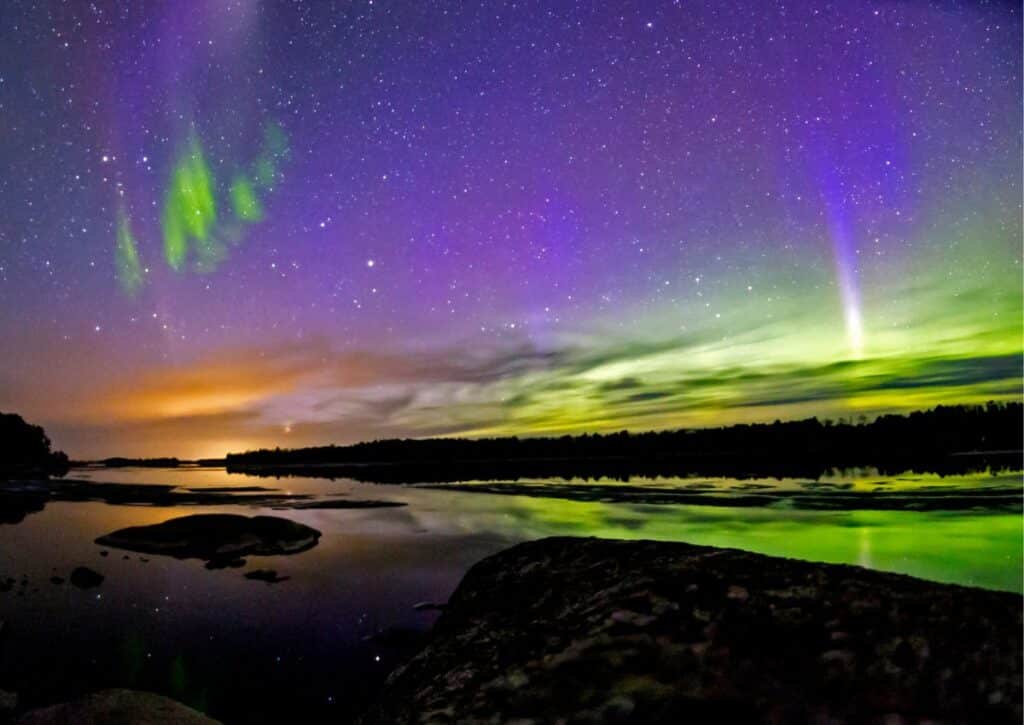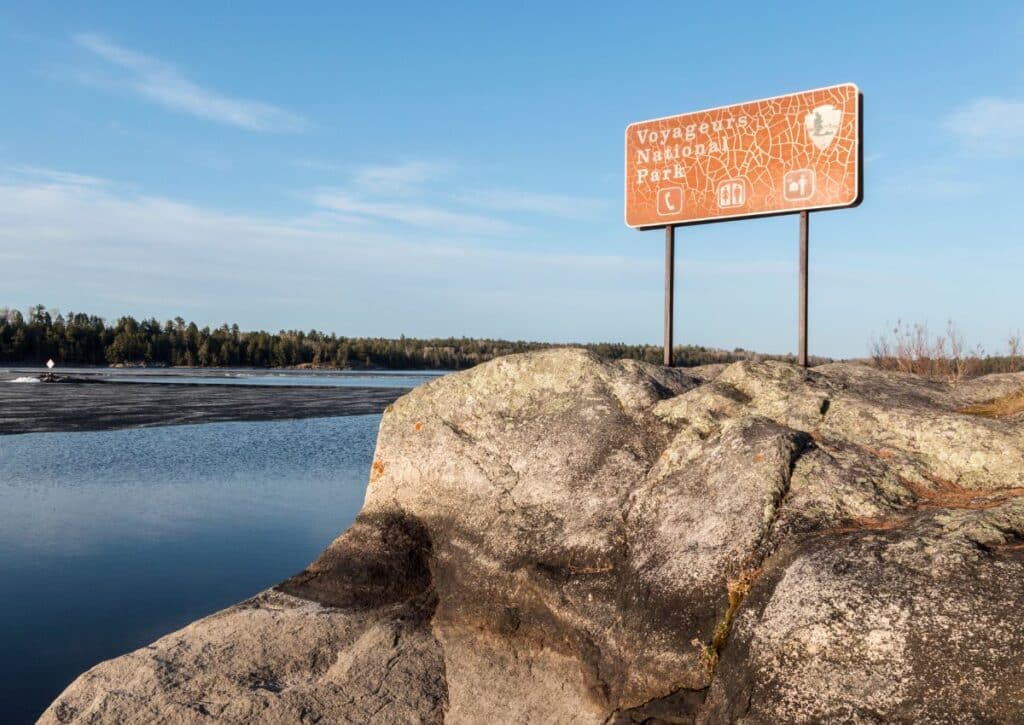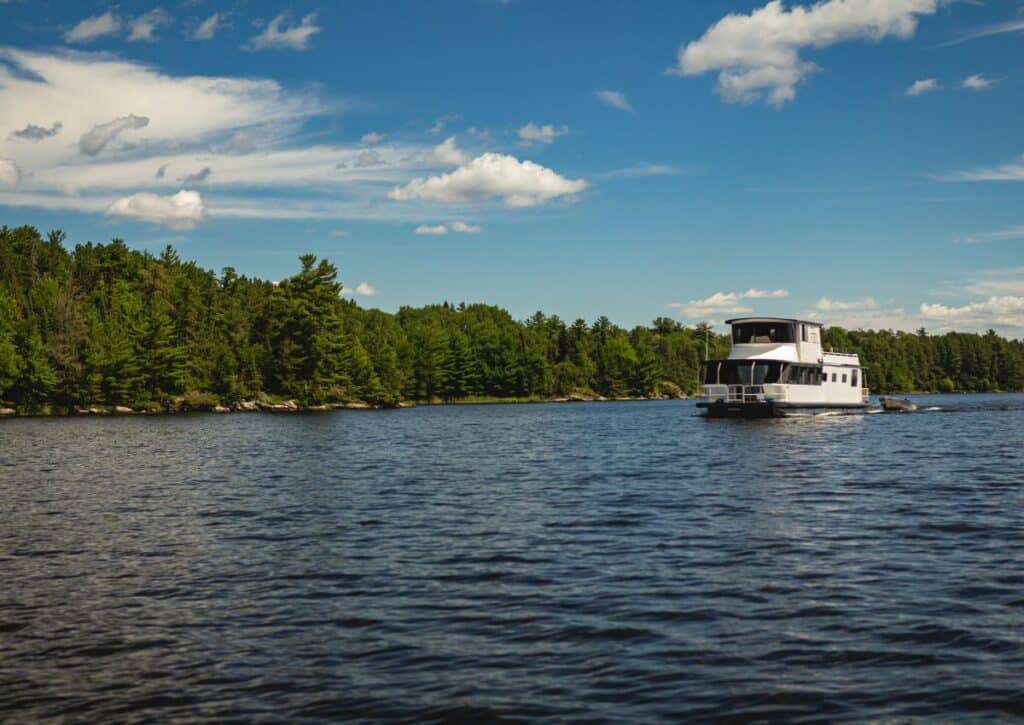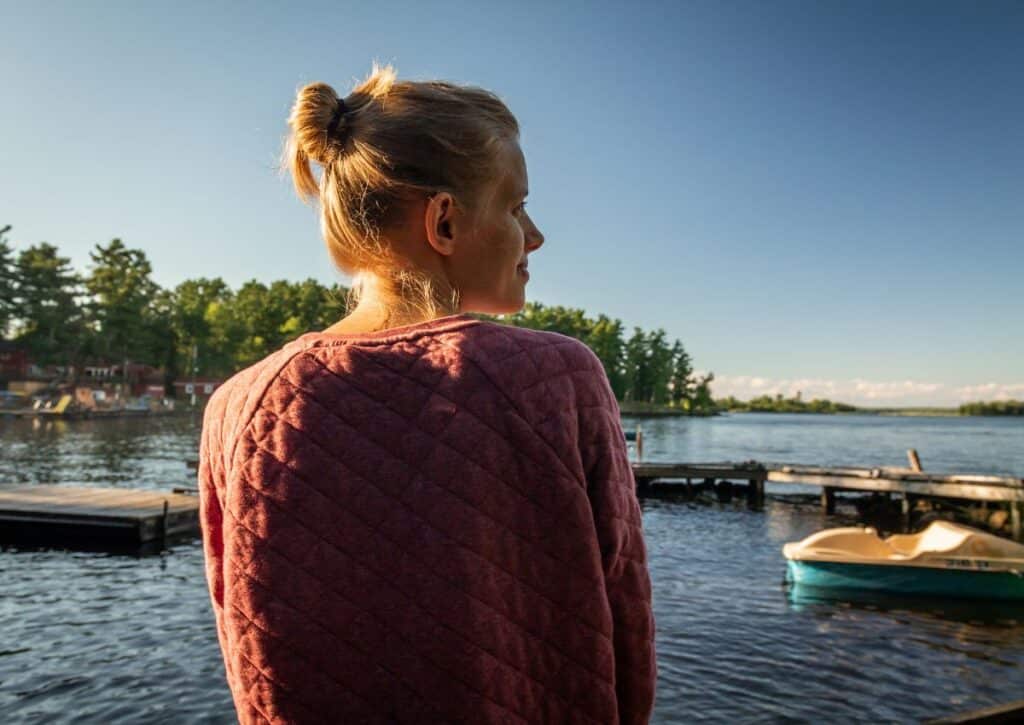Voyageurs National Park Northern Lights: Tips for the best Aurora views in Minnesota.
Voyageurs National Park, located in northern Minnesota, is a stunning destination known for its pristine lakes and lush forests.
But beyond its natural beauty, the park is also a prime location to witness one of nature’s most captivating phenomena – the Northern Lights.
Also known as the Aurora Borealis, the Northern Lights are a mesmerizing display of shimmering colors that light up the night sky and have fascinated mankind for ages.
Voyageurs National Park is a great place to view the Northern Lights, especially during the winter season when the nights are longer.
To increase your chances of seeing this natural wonder, it’s important to find a spot with an open view of the northern horizon and to plan to stay up all night.
The park’s dark skies make it an ideal location for stargazing and Northern Lights viewing, and visitors can also learn about light pollution and IDA dark sky certification through educational programs and events.
The Phenomenon of Northern Lights
Aurora Borealis Explained
The Northern Lights, also known as Aurora Borealis, are a natural phenomenon that occurs when electrically charged particles from the sun collide with particles in the Earth’s atmosphere.
These collisions cause the particles in the atmosphere to emit light, resulting in a dazzling display of colors in the night sky.
The Aurora Borealis is named after the Roman goddess of dawn, Aurora, and the Greek name for the north wind, Boreas.
It is most commonly seen in the Arctic and Antarctic regions, but can also be seen in other parts of the world.
The Colors of Northern Lights
The colors of the Northern Lights are determined by the type of gas particles that collide with the charged particles from the sun.
Oxygen produces green and red colors, while nitrogen produces blue and purple colors.
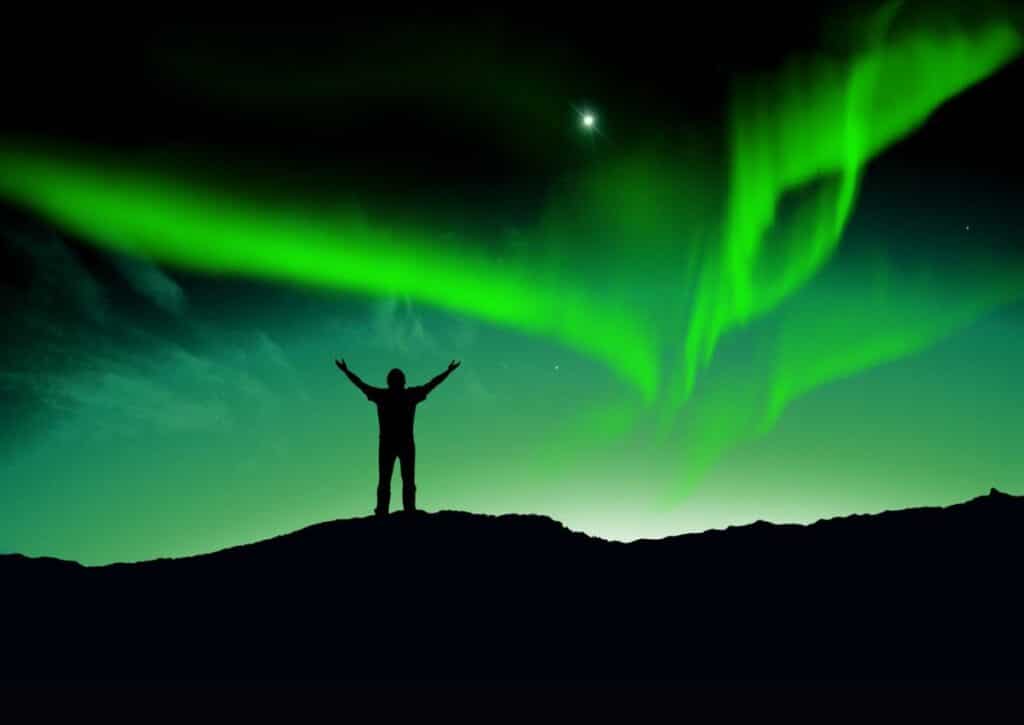
The colors can also vary in intensity and brightness depending on the strength of the solar wind.
The Impact of Sun and Earth
The Northern Lights are the result of the interaction between the sun and the Earth’s magnetosphere.
The sun constantly emits a stream of charged particles known as the solar wind.
When the solar wind reaches the Earth, it interacts with the Earth’s magnetosphere, causing the particles to be trapped in the magnetic field.
When the charged particles from the sun collide with the particles in the Earth’s atmosphere, they create the beautiful display of lights known as the Northern Lights.
The intensity and frequency of the Northern Lights are influenced by the activity of the sun, as well as the Earth’s magnetic field.
According to NASA, the Northern Lights are a visible sign of the impact of the sun on the Earth’s atmosphere and magnetic field.
Studying the Northern Lights can provide valuable information about the sun’s activity and its impact on the Earth.
In conclusion, the Northern Lights are a stunning natural phenomenon that occur when charged particles from the sun collide with particles in the Earth’s atmosphere.
The colors and intensity of the Northern Lights are determined by the type and intensity of the solar wind, as well as the Earth’s magnetic field.
Studying the Northern Lights can provide valuable insights into the sun’s activity and its impact on the Earth.
Viewing Northern Lights in Voyageurs National Park
Voyageurs National Park is a great place to view the Northern Lights, especially during the winter due to the longer nights.
The park’s location, with its dark skies and minimal light pollution, makes it an ideal spot for viewing the amazing aurora. Lets cover the best time to visit, ideal locations for viewing, and weather and darkness factors to consider when planning your trip.
Best Time to Visit
The best time to view the Northern Lights in Voyageurs National Park is during the winter months (December to February) when the nights are longer.
However, it is possible to see the aurora from late August to early April.
The ideal time to view the aurora is around midnight when the sky is darkest, but it can be seen throughout the night.
Ideal Locations for Viewing
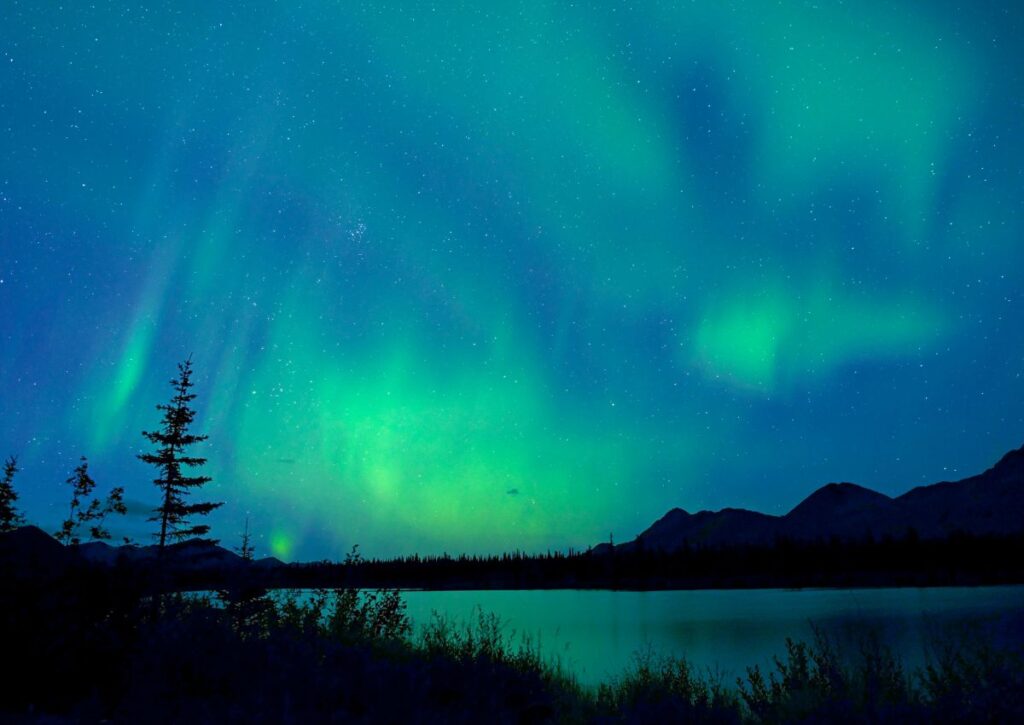
To increase your chances of viewing the Northern Lights, it is important to find a location with a clear view of the horizon and minimal light pollution. Some of the best locations in Voyageurs National Park for viewing the aurora include:
- Kabetogama Lake
- Rainy Lake Visitor Center
- Ash River
- Meadwood Road Day Use Area
- Voyageurs Forest Overlook
Weather and Darkness Factors
When planning your trip to view the Northern Lights in Voyageurs National Park, it is important to consider weather and darkness factors.
Cloudy skies and human-made lights can obscure the aurora, so be sure to check the weather forecast and find a location with minimal light pollution.
The park’s visitor centers can provide information on the best places to view the aurora.
It is also important to consider darkness factors, such as the moon and the time of night.
A bright moon can obscure the aurora, so plan your trip around the new moon or when the moon is below the horizon.
Additionally, the aurora is most visible when the sky is dark, so plan your trip for a time when there is minimal daylight.
Voyageurs National Park is an ideal location for viewing the Northern Lights. By considering the best time to visit, ideal locations for viewing, and weather and darkness factors, you can increase your chances of seeing this amazing natural phenomenon.
What months can you see the northern lights in Voyageurs National Park?
While they can technically occur at any time of the year, certain months offer better visibility and higher activity levels in Voyageurs National Park.
- Autumn and Winter: The dark, clear skies from late September to early April are generally considered the prime time for Northern Lights viewing in the park. These months provide longer nights and reduced light pollution, thereby enhancing the visibility of the Aurora.
- Peak Months: November to February are often regarded as the peak months. The extended hours of darkness and frequent clear, cold nights during these months make for ideal conditions. However, remember to bundle up, as temperatures can drop significantly.
- Spring: As the days grow longer, the window to see the Northern Lights narrows. While March and early April still offer decent chances, especially around the equinox, the frequency diminishes as summer approaches.
- Summer: Although the warm nights from May to August are excellent for stargazing and enjoying the park’s natural beauty, they are not optimal for Aurora viewing. The longer daylight hours and shorter nights reduce the chances of witnessing the Northern Lights.
A few tips to enhance your Northern Lights experience in Voyageurs:
- Check the Forecast: The Aurora forecast can provide information on expected geomagnetic activity, helping you choose the best nights for viewing.
- Escape Light Pollution: Although Voyageurs is relatively secluded, venturing to the park’s more remote areas will offer even clearer views of the sky.
- Be Patient: Aurora activity can be unpredictable. It’s often a game of patience, so dress warmly, bring a comfortable chair, and prepare for a potential wait.
The Northern Lights, or Aurora Borealis, are most visible in Voyageurs National Park from late September to early April, with peak visibility occurring between November and February due to longer, clearer nights and reduced light pollution.
Activities in Voyageurs National Park
Voyageurs National Park offers visitors a variety of activities to enjoy during their stay.
Whether it’s camping, wildlife spotting, fishing, stargazing, or moon viewing, there is something for everyone to enjoy. Below are some of the activities available in the park:
Camping in the Park
Camping is a popular activity in Voyageurs National Park. There are several campgrounds located throughout the park, including drive-in and backcountry sites.
The park also offers group campsites for larger groups. Camping in the park is a great way to experience the natural beauty of the area, with many campsites offering stunning views of the lakes and forests.
Wildlife Spotting
Voyageurs National Park is home to a variety of wildlife, including black bears, moose, wolves, and bald eagles.
Visitors can spot these animals while hiking, boating, or even from their campsite.
The park also offers guided wildlife tours for those interested in learning more about the local fauna.
Fishing Opportunities
Fishing is a popular activity in Voyageurs National Park, with many visitors coming to the park specifically for its fishing opportunities.
The park is home to several species of fish, including walleye, northern pike, and smallmouth bass.
Visitors can fish from shore or rent a boat to explore the park’s many lakes and waterways.
Stargazing and Moon Viewing
Voyageurs National Park is a designated International Dark Sky Park, making it an ideal location for stargazing and moon viewing.
Visitors can enjoy a clear view of the night sky, with little to no light pollution.
The park also offers guided stargazing tours, where visitors can learn about the constellations and other celestial objects visible from the park.
Whether you want to go fishing, spot some wildlife, or simply enjoy the beauty of the park’s forests and lakes,
Voyageurs National Park has something for everyone to enjoy. So pack your camping gear, grab your fishing rod, and head to Voyageurs for an unforgettable outdoor adventure.
History and Culture of Voyageurs National Park
Voyageurs National Park has a rich history and culture that has shaped the park into what it is today.
The park is located in northern Minnesota and is known for its beautiful lakes, forests, and wildlife.
The park is also home to the Ojibwe people who have lived in the area for thousands of years.
Ojibwe Influence
The Ojibwe people have a strong presence in Voyageurs National Park.
They have lived in the area for thousands of years and have a deep connection to the land and water. The Ojibwe people have a rich culture and traditions that are still practiced today.
Visitors to the park can learn about the Ojibwe people and their way of life by visiting the Kabetogama Lake Visitor Center.
Logging History
Logging was an important industry in the area that is now Voyageurs National Park.
The first logging camps were established in the late 1800s, and by the early 1900s, the area was a major logging center.
The logging industry had a significant impact on the land and waterways of the park. Visitors can learn about the logging history of the park by visiting the Rainy Lake Visitor Center.
Ellsworth Rock Gardens
The Ellsworth Rock Gardens are a unique feature of Voyageurs National Park. The gardens were created by a man named Jack Ellsworth who lived in the park in the 1940s.
Ellsworth was an artist and gardener who created the gardens using rocks and plants found in the park.
The gardens are a beautiful and peaceful place to visit and are a testament to the creativity and ingenuity of the people who have lived in the park.
Voyageurs National Park has a rich history and culture that is worth exploring.
Visitors to the park can learn about the Ojibwe people, the logging history, and the unique features of the park such as the Ellsworth Rock Gardens.
The park is a beautiful and peaceful place that is worth visiting for anyone who loves nature and history.
Key Takeaways
Voyageurs National Park is a prime location to witness the captivating Northern Lights.
Visitors can increase their chances of seeing the Northern Lights by finding a spot with an open view of the northern horizon and planning to stay up all night.
The park offers educational programs and events to learn about light pollution and IDA dark sky certification.
Frequently Asked Questions
How can I get to Voyageurs National Park?
Voyageurs National Park can be accessed by car, boat, or plane. The nearest major airport is the Minneapolis-Saint Paul International Airport, which is approximately a four-hour drive from the park. Visitors can also take a shuttle or rent a car to get to the park. Once at the park, visitors can explore the park by boat, canoe, or kayak.
What are some things to do at Voyageurs National Park?
There are many things to do at Voyageurs National Park. Visitors can go hiking, fishing, boating, and camping. The park also offers ranger-led programs and tours, as well as stargazing and northern lights viewing opportunities.
Where can I stay near Voyageurs National Park?
There are several lodging options near Voyageurs National Park, including campgrounds, cabins, and lodges. Some popular options include the Kabetogama Lake Visitor Center, Ash River Visitor Center, and the Rainy Lake Visitor Center.
What is the best time of year to see the northern lights in Minnesota?
The best time to see the northern lights in Minnesota is during the fall and winter months, from September to March. During this time, the nights are longer and darker, which makes it easier to see the aurora. However, the northern lights are a natural phenomenon and cannot be guaranteed.
Where is the best place to see the northern lights in Minnesota?
Voyageurs National Park is one of the best places to see the northern lights in Minnesota. The park’s location in northern Minnesota, away from city lights, provides optimal viewing conditions. Visitors can view the northern lights from the park’s many lakes and shoreline areas.
What time of night is the northern lights most visible?
The northern lights are most visible after sunset and before sunrise, when the sky is dark. However, the intensity and visibility of the aurora can vary throughout the night. Visitors should plan to stay up late and be patient when searching for the northern lights.

